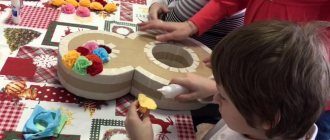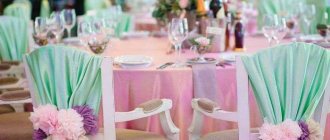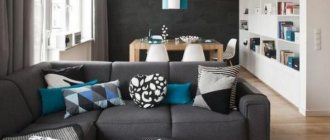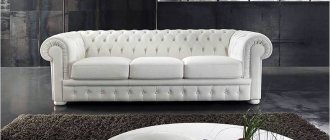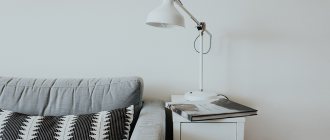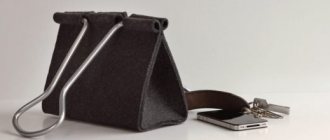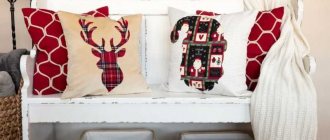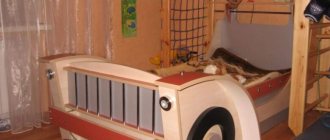Every house has furniture. How often the upholstery of a chair or sofa can become unusable from one careless, clumsy movement. If you accidentally spill juice or coffee, the chair will never be the same again. And the traces of animals in the house also leave much to be desired. Therefore, it is better to protect the furniture. I need a cover for a chair, how to sew it. There is a video at the bottom of the article. If you want to buy a chair cover, follow this link and choose.
Of course, you can spend a lot of money on purchasing new upholstered furniture. You can buy covers that are also not cheap. But we offer a very simple way to solve the problem - to sew a cover for the chair with your own hands. And then onto the sofa. Thus, you can update damaged furniture and change the interior of the room .
Options for sofa and chair covers:
- Cover without decorative ruffle. There are two square pillows without decorative trim.
- Cover with straight ruffle. It includes two square throw pillows.
- A ruffle in the fold is sewn to the cover. Two decorative rectangular pillows trimmed with ruffled pleats. With a bed width of 1950 cm, the set includes three pillows.
- In the place where the straight ruffle cover is stitched, a decorative fringe is sewn. Two decorative square pillows with tassels at the corners.
- Instead of a ruffle, a decorative fringe in the form of twisted threads is sewn on. Two square throw pillows trimmed with decorative fringe.
Benefits of using chair covers
A cover for a computer chair or upholstered furniture can radically change the interior, become its main element, and improve the atmosphere as a whole. It completely covers the furniture upholstery, giving it a neat look. To prevent the material from sliding off the armrests, it can be secured with additional decorative elements or ribbons.
Making a bedspread for classic furniture and a cover for a computer chair with your own hands has the following advantages:
- Saving money. There is no need to pay for the work of a professional seamstress, whose services are not cheap. In addition, you can choose a fabric that is affordable.
- Selecting suitable fabric and product design. Here the craftswoman has the right to realize all her fantasies within the chosen style. Additionally, she can decorate the cape with decorative elements.
- Acquiring new skills. Decorating your home is a fun activity. Having learned to sew, the housewife can refresh the interior more often.
- The manufacture of the case is strictly according to the parameters. There is no need to adjust the finished cape. The risk of altering the product and damaging the material is eliminated.
Chair covers not only decorate the furniture, but also protect it from dirt, damage by pets, and quick erasure of the original upholstery.
Varieties
Every day, the developers of blankets, bedspreads, and covers do not stop developing their works, continuing to fantasize and use new tricks. As a result, this led to a wide variety of styles, from simple to multifunctional, for all models of sofas and armchairs.
Types of capes:
- Universal . The material is shaped like a rectangular towel, which is simply laid over the sofa. It suits both sofas and armchairs.
- Fragmentary . Rectangular material secured with Velcro or ties.
- With additional functionality. Includes small pockets for the remote control and other household items, this is important for small rooms.
- Euro cover or tension cape . It completely covers upholstered furniture, repeating its shape and bend, smoothing out all the unevenness on the surface.
- Plaid with different effects. The most favorite to use are housewives who like to wrap themselves in a blanket that retains heat, which will not only warm, but also protect the sofa.
Choosing a suitable product design
Before sewing a chair cover with your own hands, you should think about what fabric to choose so that the furniture fits into the overall interior. The design of the product may be different, but each style has its own characteristics. They are presented in the table.
| Design type | Characteristic |
| Patchwork | This cover is a combination of a large number of patches of different colors and shapes. The palette of shades is usually bright, but if the product will be used in Provence or Scandinavian style, then it is better to give preference to pastel, muted tones. This DIY chair cover will add personality to the room. It looks festive and impressive. For a beginner, sewing a product in the patchwork style will be somewhat difficult, since it involves sewing together a large number of fragments, which must first be folded in a certain order and overcast. |
| Loft | The loft style combines wide space, maximum sunny color and rough wall decoration (brick, concrete). Fur products are especially popular for him. This type of chair cover must be made carefully with your own hands. Natural material is expensive, but it is soft, cozy and warm. High-quality faux fur is not inferior in properties to it. The length of the pile may vary. As for color, in this style it is better to use light, airy shades. A fur cover will make the interior rich and more presentable, but it is important not to overdo it. |
| Shabby chic | This style is characterized by the use of faded and worn fabrics to create an antique effect. Here it is better to use muted shades and light floral patterns. Geometric patterns in this case are inappropriate, as are bright colors. To sew the cover, you can use silk or satin fabric. Brushes and frills are suitable for decoration. |
| Baroque | Covers with frills and flounces are appropriate for this style. They add romance. Folds can be full or incomplete, and can be on the front of the chair or on the sides. |
Loft
Patchwork
Baroque
Shabby chic
Fabric selection
Before purchasing fabric for a chair cover, you should pay attention to some criteria that will help in your choice, namely:
- Strength. You should only focus on materials with high strength;
- Fabric color. In this case, you can rely on imagination and taste, but it is best to select the shade of the material according to the color scheme of the room’s interior;
- Fabric preparation. Immediately after purchasing, you need to wash and dry the fabric; if this is not done, the sewn cover will shrink during the washing process and will no longer fit the size of the chair.
The product can be attached with an elastic band
Preparation of materials and tools
To properly make a bedspread for a chair with your own hands, you need to prepare for the work, and also carefully choose the material. For sewing you will need the following tools:
- sewing machine, needle and pins for pinning the pattern of the chair cover;
- furniture staples;
- paper pattern;
- threads;
- pencil, chalk, soap;
- scissors;
- measuring tape;
- graph paper;
- zippers, decorative elements, fasteners.
Of course, you can try to sew a bedspread for a chair with your own hands, but you need to do this in such a way as not to spoil the expensive fabric. To begin with, it is better to practice using rough material - an ordinary sheet.
In order for the furniture to look presentable, you need to choose the right material. It should fit well on the base, not wrinkle, be resistant to abrasion, and be easy to clean or machine washable. Typically the following fabrics are used for sewing:
- Cotton. The advantage of this material is its naturalness. It allows air to pass through well, does not cause allergies, but quickly wears out and tears, because it does not contain artificial fibers. Cotton shrinks after washing and may shrink in size.
- Velours. The fabric is soft and has a beautiful appearance. The fabric is wear-resistant, easy to care for, but accumulates dust. Dirt stains cannot always be removed without damaging the material.
- Flock. It is dense, durable, but at the same time soft and delicate. The material is not subject to deformation and can be used for many years. The product does not fade when exposed to direct sunlight and is resistant to moisture.
- Relax. This fabric is easy to care for and abrasion resistant. Its bottom layer is made of cotton and polyester, the top layer is made of polyamide pile. They are connected to each other using rubber. This material can be cleaned with detergents.
- Nubuck. It is pleasant to the touch, soft, and has a beautiful, velvety surface. The fabric can last for decades.
Using an easy way to sew a chair cover, you can use other materials: linen canvas, jacquard, microfiber, chenille, satin, silk, upholstery fabric.
Sewing supplies
Cotton
Flock
Relax
Jacquard
Linen canvas
Velours
Silk
Natural nubuck
Chenille
Microfiber
Upholstery fabric
Tapestry knitted capes
In the past, tapestry covers for sofas, armchairs, and ottomans served as decor for upholstered furniture and were considered luxury and wealth. Tapestry capes were specially sewn to order from expensive threads; a lot of time was spent creating unusually beautiful patterns by which one could recognize the hand of the master. Nowadays, manual work is being replaced by technology, and the cooking process has accelerated significantly. They began to use cheaper threads and began to appreciate such decor less.
But tapestry bedspreads have not lost their sophistication and beauty in the interior. Moreover, harmonious shades and patterns will emphasize your refined, subtle taste.
The tapestry is created using sophisticated technologies developed by the ancient Egyptians. Modern tapestry production is very different from ancient Egyptian production. It all starts with a sketch. You can transfer any drawing, landscape, or still life to the future canvas. Designers break the image into 1000 colored dots, each of which determines the color of the yarn for the future fabric.
There are approximately 300 shades in the tapestry palette, while the threads used to create the canvas come in only five colors. When we deal with paints, we can easily get any shade just by mixing colors. In the invention of shades, threads are mixed on the canvas to create new shades.
Features and Benefits
The peculiarities of the material include the weaving of three or more multi-colored threads; therefore, the fabric is not dyed after weaving. Moreover, they are distinguished not only by shades, sizes, method and complexity of cut, but also by their unique decor. This could be:
- fringe;
- applique;
- sprint drawings;
- classic embroidery;
- lace.
All this added sophistication and beauty not only to the canvas, but also to the interior in general.
Tapestry fabrics are made from different materials.
These include:
- yarn;
- textile;
- non-fabric materials;
- straw
Density, thickness, relief can be chosen to taste, since there are a lot of varieties. Print, thematic patterns, drawings, color palette - everything according to your wishes. It has the power to refresh not only upholstered furniture, but also the atmosphere of the room in general.
You can choose your future cape either en masse or individually, which will cost a little more. The manual method is still preserved and such work continues to be valued, which is characteristic of the individual manufacturing method. Massive work is performed by machines, so such models are cheaper than hand-woven fabrics. Each material requires its own individual care, which we will discuss below.
Any type of work (cloak, cover, bedspread) will not be difficult to put on and take off from furniture.
In a large number of cases, tapestry bedspreads saved the day and diluted the dull atmosphere. Moreover, experts in harmonious design ideas will appreciate such an expensive gift. The hypoallergenic natural composition of the fabric of the covers is safe for children and the elderly.
The material from which the cover is made is very wear-resistant, does not shrink and does not lose its bright colors. Basically, such bedspreads serve as protection against dust mites, dirt, and paints, but families with small children should wash them more often. Of course, you will save the sofa from children's paints and felt-tip pens, but you will not save the cape, which may cost no less than your sofa. For this, it is also important to consider proper care.
Such bedspreads can protect from prying eyes mechanical damage acquired over time or due to carelessness. It is advisable to purchase such a cape before the upholstery is damaged. You can maintain the look and smell of new furniture.
You can soften a hard sofa if you use fabrics with several layers or special inserts. Recommended for use on slippery sofas.
To make this cape last a long time:
- It is best to wash tapestry bedspreads by hand. If it is preferable for you to use a washing machine, do not select the “sharp spin” mode.
- Choose a temperature no more than 30°.
- Dry the material without using heating devices.
- The maximum temperature of the iron during ironing melts synthetic fibers.
- Not many types of materials require dry cleaning.
If you are temporarily not using the material, wrap it in any sheet other than polyethylene and place it in an open, breathable bag.
Sewing stages
This section contains step-by-step instructions on how to sew a chair cover with your own hands. It will be useful for both beginners and experienced needlewomen. Furniture can have different configurations, so to sew a cape in each individual case, you need to take measurements of all its elements. Patterns for sewing a chair cover are also required. They are drawn by the craftswoman herself in accordance with the measurements received.
Pattern creation and cutting
It is necessary to measure all parts of the chair: the back, armrests, seat and cushion. First you need to determine where the seams will be. They can be marked directly on the rough fabric. If the cover has a design different from the shape of the furniture, then the seams need to be drawn directly on the upholstery, so that they can then be transferred to the material. At this stage, you need to take into account the inserts for contour alignment, bends, and thickness.
In order not to confuse the sizes, you can write them on the wrong side of the cut parts. When cutting, you need to take into account the darts that allow the cover to fit perfectly around the chair without any bumps. Don’t forget about tucks, folds, frills and hems.
A simple pattern for a chair cover with armrests is made so that, in addition to the seam allowances, there is still 20 cm of fabric left for adjusting the product, bends and overlaps. If some pieces of furniture have an unusual shape, then the pattern is drawn like this: a thin fabric is applied to the fragment and crimped on all sides. After the measurements have been made, you need to make patterns on graph paper. Next, the patterns are laid out on the material so that as little waste as possible remains. The patterns need to be outlined with chalk or pencil, taking into account the allowances.
The cut parts must be ironed from top to bottom along the grain line.
Measure the chair
Make a pattern
Cut out the details on the fabric
Iron the cut pieces
Pattern option for a simple case
Fit
For the armrests you need to make 2 patterns: outer and inner. Both fragments should be sewn together. In this case, the fabric is folded in half, and seam lines and grain threads are drawn onto it with a pencil.
To fit the resulting patterns, you need to attach them to the chair and pin them with pins. In this case, all folds are tucked in, and seam lines are marked on the material. All excess fabric fragments must be eliminated and darts formed.
Since there will be tucks on the armrests, you need to wrap them on the outside under the curve. There will be a lot of excess fabric in this place that needs to be cut off. The tucks are secured with pins. The seat pattern must be placed on the chair and combined with the rest of the parts. At this stage the darts are sewn together. The cutting of the frills is done last.
Try on the details
Tack
Attach patterns for the front parts of the armrest, try on and baste
Sewing
If the pattern for the chair seat cover is ready, you can start sewing all the fragments together. The presented work consists of the following stages:
- Sewing darts and frills. The seam must be strictly along the mark, otherwise the material may warp, causing the cover to lie with folds.
- Sweeping all parts of the armrest. This work must be done on the wrong side so as not to damage the front. After this, the product must be turned out, and small cuts must be made in the corners.
- Connecting the armrests to the seat.
- Stitching the lower part of the inner part of the backrest to the far edge of the seat. At the same stage, the outer part of the product is attached.
- Basting hem details. Immediately you need to lay all the assemblies evenly.
- Installation of lightning. It is better to do this at the side seam.
After sewing all the parts, the cover needs to be turned right side out and put on the chair. In this position, the product is adjusted to the ideal. If it sits well on the furniture and there are no folds, you can sew it on a machine. The last step is to decorate the cover with ribbons or additional elements. If you have any questions, we recommend watching a video on how to sew a chair cover yourself.
Since sewing a cover for a computer chair with your own hands is not difficult, every craftswoman can easily update the interior of a room and refresh the appearance of the furniture. If the product turns out well from rough fabric, then the entire sewing process is made from expensive material. All work will take 1-2 days.
Sew the front part to the seat, trim the seam with braid
Process details with edging
Sew on a machine
Ready case
Is it possible without a pattern?
A cover sewn without a pattern may become slightly deformed and lose its proper appearance. That is why the cover for the chair should be sewn according to patterns, so that during the work you do not waste a large amount of material and, as a result, the cover looks high-quality and neat.
Seashell chair cover
Thus, sewing a cover for a car seat or home furniture is not difficult. Using the patterns provided on the Internet, in a couple of minutes you can make a drawing and sew a protective product for a chair, rocking chair, and even for a sofa element.
We will reveal it locally
Cutting a sofa cover locally is technologically simpler than sewing a dress cover without a pattern, and developing patterns for the cover, and is also quite economical: up to 25% of the cutting area is wasted, depending on the thickness of the seat and backrest. This method is suitable for simple shaped sofas.
With the opening in place, the trace is sewn. sofa covers:
- Covers for geometrically simple, non-folding sofas without armrests, common in modern style interiors, and for book sofas, see below.
- Linings (case covers) made of technical fabric for dress covers sewn without a pattern, so as not to bother with the pattern of the cover case.
- Everyday saving covers (item 3 in the figure), incl. on the sofa in a formal cover.
How to sew a sofa cover with cutting in place is shown in pos. 1 and 2 pictures:
Sewing a sofa cover with cutting to place
Recommendations to reinforce the seams with wooden inserts are most likely either an unqualified translation of the original source, or simply an intuitive guess. In fact, using suitable pieces of wood, folds are formed to reinforce the seams with a turn, see above. If the pieces of wood are left in the seams, they will soon rub through both the cover and the upholstery of the sofa. At pos. 4 gives examples of how to decoratively decorate the covers of the wings of the cover on the armrests; Of course, your own solutions are also possible. If covers are required only for armrests, they are designed in a similar way; In this case, fabric waste is zero or almost zero.
About the role of the case cover
The undercover, firstly, improves the adhesion of the cover made of beautiful but slippery fabric to the sofa. In this case, it is sewn from thin cotton fabric, for example, linen. Old yellowed sheets are perfect; a slipcover made from them holds the satin cover on the faux leather sofa as if sewn on.
Another purpose of the cover is to protect the sofa itself from dirt and grease. If the sofa is leather, this is very important. In this case, the undercover is sewn in 3 layers: a fairly dense technical fabric (linen canvas, matting; you can use propylene from bags) is placed on the upholstery of the sofa, followed by a layer of padding polyester or, better yet, holofiber, and the cover holds the canvas, as in the previous one. case.
For a book
Thanks to Ikea, everyone now knows what a Eurobook sofa is, see figure:
Construction of a Eurobook sofa
It is not said as a reproach: book sofas are indeed very comfortable, and in small one- or two-room apartments they are sometimes irreplaceable. It is only necessary to note that sofa beds of exactly the same design were produced in the USSR back when not every average person in Europe had heard of the embryo of the EU in the form of Benelux. True, sofa sofas were supplied to furniture stores in single copies, which had a small factory defect. Conditional ones were distributed at the top according to orders or were bought up through connections by those admitted to the hairy hands of the Ivan Ivanovichs. According to rumors, just such a sofa bed stood in the Dnepropetrovsk (in his hometown) apartment of the most Ivan Ivanovich of all Ivan Ivanovichs - the unforgettable Leonid Ilyich. Quite plausible: he was a simple and good man, only weak for his post. This is probably why they chose him when the bald clown in power turned out to be no better than the mustachioed monster. But let's get back to the topic.
You need at least 2 separate covers for a sofa book, or 3 if you want the folded back to not stand out in color. You may also need to cover the armrests; then you will need 4 or 5 separate covers. Covers for the armrests of a book sofa are cut in place, as described above, but with one condition: at the bottom, under the underside of the armrests, they must be tightly fastened with a zipper with large teeth, otherwise the mechanism will always be tighten and soon break; The option with a rubber band does not help with this. In fact, covers for the armrests of book sofas are their sore spot, which, as far as we know, has not yet been cured by anyone.
There are no problems with covers for the mattresses of the sofa-book. The pattern is given on the left in Fig. with sizes for popular models:
How to sew a cover for a sofa book
How the corners are stitched is shown in the center. The cover of the book sofa is tightened with an elastic band (on the right in the figure), but first you need to mark the armhole in place along the mechanism. It is a simple straight cut for the boss that fits into the cutout of the lever and is edged with trouser braid; Bias tape wears out soon. The armhole is pulled together from the bottom with an elastic band. To put on or take off the cover, you will first need to remove the linkage; this is done simply by hand without tools, see the instructions for the sofas.
Is it possible not to cover the sofa?
Of course, you don’t have to use covers on upholstered furniture, but even with due care, the upholstery material will still wear out and wear out. Therefore, over time, your upholstered furniture will in any case lose its appearance and will require reupholstery or complete replacement.
Use sofa covers to preserve the appearance of your furniture.
And if you have small children or pets at home, then the upholstery is almost 100% likely to someday suffer from their actions. Using covers on upholstered furniture is more of a necessity than just a desire to decorate your home. Buy or sew capes, and then your furniture will serve you for a long time and will delight you with its appearance.
Quilted bedspreads
The sophisticated color scheme will lift your spirits and please the eye. The advantages include the fact that they have a sealant inserted between the main material and the lining fabric, most often a padding polyester.
Thanks to this combination of fabrics, the bedspreads are lush and soft, hiding the folds on the sofa. There are these types of stitches:
- thread stitching - expensive models;
- thermal stitch.
Thermal stitching is used only for bedspreads made of artificial fabrics. It involves bonding the layers of a bedspread using a special device that precisely melts synthetic fibers.
It is voluminous and takes up a lot of storage space. Therefore, it is difficult to wash. Any bedspread must be washed at least 2 times a year. Or clean it from dust and be sure to ventilate it.
Selection of models by style
The easiest way is to choose a simple monochromatic quilted bedspread; the only difficulty will be the selection of harmonious shades.
Bedspreads decorated with small monotonous flowers are typical of Provence. Monochromatic colors, straight lines or checkered patterns are preferable to Classicism. The patchwork technique, as a rule, harmoniously combines with the country style: highlighted squares with delicate roses and a diluted picture with bed tones will create charm and comfort.
An oversized bedspread on your upholstered furniture will look untidy, dirty and give the effect of disorder; the bedspread should correspond to 110 by 140 cm. For a double bed, the following standards have been noted: 200 by 220 cm.
European beds are famous for their maximum sizes, so a bedspread for a standard double bed will be small, so choose sizes from 220 by 250 cm to 230 by 250 cm.
Sets
Most sofas and armchairs have standard sizes, so manufacturers offer covers whose main feature is versatility. To ensure a perfect fit on chairs of any shape, an elastic band is used.
Today, there are not only covers for office chairs on sale, but also a large assortment of sets designed for entire sets of upholstered furniture. Most often, the set includes a sofa cover and covers for 2 chairs.
To create functional sets, durable elastic fabrics are used; they easily stretch and take the shape of the sides and seat, and also reliably protect the armrests.
The flounces sewn to the bottom of the cape are ideal for furniture with or without legs. A stylish hand-sewn “skirt” will organically fit into any traditional interior. In modern high-tech, loft or minimalist styles, it is better to use more strict and laconic forms.
The upholstery on chairs wears out much faster than on sofas or armchairs. With the help of a new cover, you can quickly turn an old kitchen chair into a bright element of the interior. An excellent solution could be to purchase several tension sets for furniture at once.
Buy a casual set for office chairs or chairs for daily use and a luxurious holiday option for entertaining important guests. For the summer, it is better to choose products made from thin cotton materials; in cold weather, you need cozy soft covers made of faux fur, velor or beautiful crocheted woolen products.
PHOTO GALLERY (more than 120 photos)
Do not forget to take measurements of upholstered furniture before choosing and purchasing a bedspread. The question becomes much more complicated and takes on an even greater degree of importance if you choose not a ready-made blanket, but fabric for sewing. Change the design of your apartment, rearrange it, and bright floral colors will help you forget about your bad mood. Experts have proven that interior renovation is the best way to prevent depression and a small step towards more global changes, for the better in life. Try to make your home comfortable and cozy, then your nest will unconsciously please not only you, but also everyone around you. After all, this is the most important thing for housewives. After reading the information, please leave your ratings and reasoning in the comments. They will be useful to other readers. Your opinion is very important to us. Thank you for your participation. We appreciate your every feedback and time spent.
The new furniture looks luxurious. Excellent upholstery, armrests and seats - all in perfect order. Over time, the sofa and armchairs may lose their original appearance. The fabric is wiped out, fades, various stains and puffs form. After several years of active use, upholstered furniture turns from a spectacular element of the interior into an unpresentable object. Most often, old furniture is covered with a blanket or blanket, but this only half solves the problem; the side walls remain uncovered. An excellent way out of the situation are removable covers for chairs, which perfectly protect furniture from mechanical stress.


